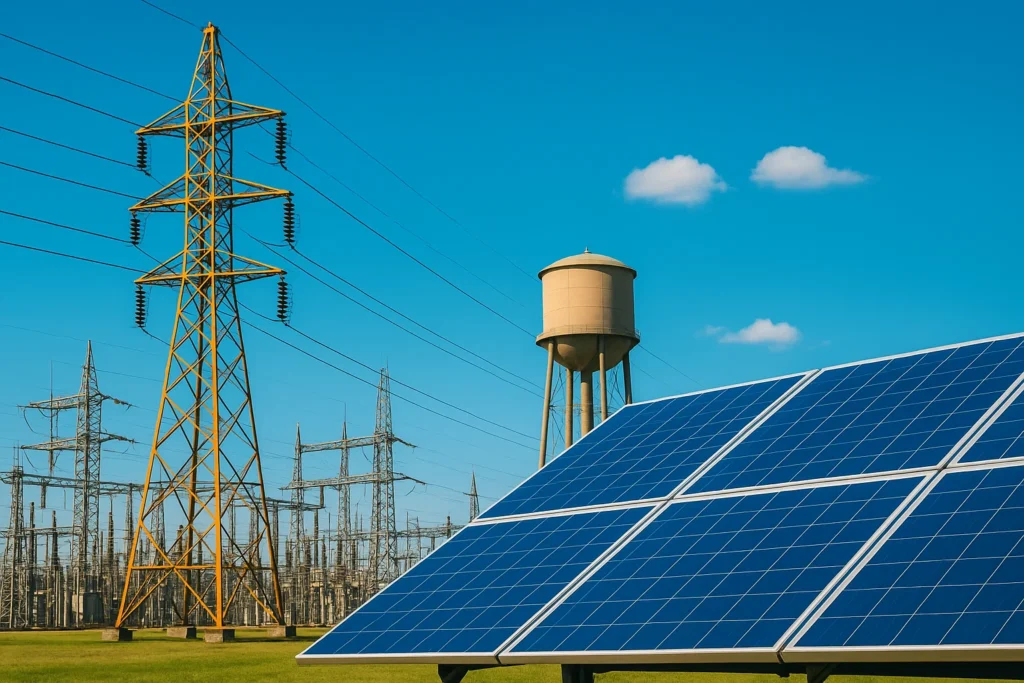Utilities
- by:
- Nick H
Key Points
The utilities sector is evolving rapidly, driven by the global shift toward renewable energy, smart grids, and digital technologies.
Massive investments in solar, wind, and grid modernization are creating new growth opportunities while supporting sustainability and carbon reduction goals.
Leading companies such as NextEra Energy, Duke Energy, Enel, and Veolia are setting the pace in clean energy
For adsense add
Advertisement

affiliate add
For adsense add
Mail Sign Up
Get The Latest News & Stock Picks
Stay ahead of the market with expert news, actionable tips, and exclusive stock picks delivered straight to your inbox. Join a community of investors who value real insights and smarter strategies. Sign up now and get the edge you need to invest with confidence.
By submitting your email, you agree to receive updates and promotional content from our team. You can unsubscribe at any time. For more details, please review our Privacy Policy.
For adsense add
For adsense add
The utilities sector has long been seen as the bedrock of the economy. Even as the world rapidly advances into the digital age, utilities—electricity, water, natural gas, and now renewable energy—remain essential to modern life. These companies are responsible for keeping the lights on, powering industries, delivering clean water, and increasingly, enabling the shift to a sustainable future. Investors have traditionally turned to utilities for stability, income, and a measure of safety, but today’s sector is more dynamic than ever.

Growth Drivers and Market Prospects
Despite its reputation for stability, the utilities sector is undergoing a quiet revolution. Several key factors are now reshaping the landscape and providing fresh avenues for growth:
Renewable Energy Expansion: The global push toward cleaner energy sources is leading utilities to invest heavily in solar, wind, and hydroelectric power. Renewable energy capacity is expected to double by 2030, and utilities are at the forefront of this transition.
Grid Modernization: Utilities are upgrading aging infrastructure, integrating smart meters, automation, and grid storage to improve reliability and efficiency.
Electrification of Transport: The growing adoption of electric vehicles is driving demand for power and prompting utilities to expand charging infrastructure.
Regulatory Support: Many governments are enacting incentives, tax credits, and mandates for clean energy production and carbon reduction, directly benefiting forward-thinking utility companies.
Population and Urban Growth: Expanding urban centers and rising global populations are boosting demand for water, energy, and essential services.
Challenges and Headwinds
While opportunities are abundant, the utilities sector must also navigate a unique set of risks and operational challenges:
Regulatory Risk: Utilities are among the most heavily regulated businesses. Policy shifts, rate cases, and political uncertainty can impact profitability and long-term planning.
Capital Intensity: Upgrading and maintaining infrastructure is enormously expensive, requiring substantial borrowing and disciplined capital allocation.
Weather and Climate Risk: Extreme weather events and changing climate patterns threaten infrastructure, reliability, and can lead to unexpected costs.
Commodity Price Volatility: Fluctuations in the price of natural gas, coal, or other inputs can squeeze margins and impact earnings.
Transition Costs: The shift to renewables, while promising, comes with transition costs as companies phase out older power plants and invest in new technologies.
Sector Trends to Watch in 2025 and Beyond
Utilities are embracing new technologies and business models. Smart grids and digital automation are helping companies detect problems before they become outages, while advanced battery storage solutions are allowing for better integration of intermittent renewables like solar and wind. Decentralized power generation, including rooftop solar and microgrids, is gaining ground, giving customers more control over their energy use and placing new demands on utility business models.
Electrification is moving beyond vehicles. More industries are looking to electrify manufacturing processes, further raising the importance of robust, reliable utility services. Water utilities are also innovating, using data analytics and IoT sensors to minimize waste, detect leaks, and optimize delivery in the face of climate-driven droughts.
Sustainability is now central to the sector’s strategy. Environmental, Social, and Governance (ESG) standards are influencing investment decisions and driving utilities to set ambitious goals for decarbonization and clean energy development.
Major Utilities Companies and Their Impact
In the United States, NextEra Energy has become a leader in renewable power, boasting one of the world’s largest portfolios of wind and solar projects. Duke Energy and Dominion Energy are making significant investments in both grid modernization and renewables, while still operating large fleets of traditional power plants. Southern Company and American Electric Power continue to provide reliable service across multiple states, with plans to decarbonize their portfolios over the coming decades.
Globally, companies like Enel (Italy), Iberdrola (Spain), and China Yangtze Power are spearheading the transition to green energy on a massive scale. These firms not only power millions of homes but also shape energy policy and drive technological progress in their respective regions.
Water utilities such as American Water Works and Veolia (France) are investing in advanced purification and delivery systems to ensure clean, safe water as urbanization accelerates and climate risks mount.

How Utilities Companies Shape the Sector
Utilities companies serve as the backbone of economic development and daily life. Their investments in clean energy, grid modernization, and infrastructure resilience determine the reliability and sustainability of entire regions. By diversifying into renewables, building smarter grids, and embracing digital transformation, utilities are moving from being simple service providers to key players in the fight against climate change and resource scarcity.
The influence of these companies extends beyond local markets. Global utilities collaborate on technology, share best practices, and often invest across borders. Their financial stability and scale give them the capacity to drive major changes, setting benchmarks for other sectors to follow.
Why the Utilities Sector Matters to Investors
The utilities sector has a unique appeal for investors seeking a blend of reliability and growth potential:
Steady Income: Utilities are known for paying regular dividends, supported by predictable cash flows from essential services.
Defensive Qualities: Demand for electricity, water, and gas tends to remain stable even during economic downturns.
Sustainable Growth: The shift to renewables and new infrastructure projects offers long-term upside and the chance to participate in the green transition.
Inflation Protection: Many utility rates are linked to inflation or subject to periodic adjustment, providing a buffer in volatile economic times.
However, investors should be aware of the sector’s challenges, including regulatory constraints, high capital needs, and exposure to unpredictable weather events. Careful research and attention to each company’s strategy for innovation and sustainability will be critical to making informed investment decisions.
For adsense add






